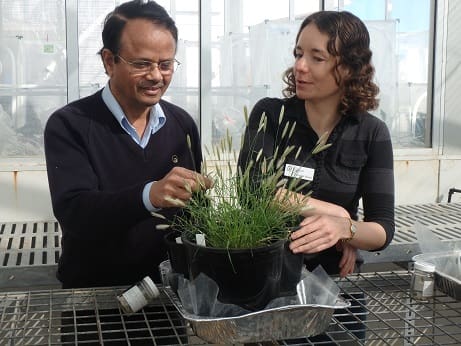GROWERS should act early and stay on top of emerging weeds during summer and autumn to optimise soil moisture and nutrient conservation and minimise the ‘green bridge’ for carry-over of pests and diseases.
To achieve that, weed species identification is key to successful control and herbicides are best used at weed seedling stages.
This also reduces the need for the highest label rates of a knockdown herbicide before seeding.
Targeting early weed growth
Control of small weeds, particularly seedlings, in summer and autumn is achieved with integrated weed management (IWM) practices that include herbicides, strategic cultivation and/or grazing tactics.
Past research funded by the Grains Research and Development Corporation (GRDC) in Western Australia has indicated controlling weeds early and conserving an extra 20 millimetres of stored soil moisture could be worth an extra 0.5 tonnes a hectare in crop yield.
It has found if summer weeds are allowed to establish in the fallow, these will start extracting water from depth (of more than 100 millimetres in some regions) within about 12 days.
Optical sprayers
Optical spot spraying of isolated or small patches of weeds before seeding, or in wide-row cropping systems early in the growing season, can reduce herbicide use and help ensure sustainability of key active ingredients.
There are two main units available – WEEDit and Weedseeker. The key difference is that WEEDit is typically a tow-behind machine and uses one sensor ‘eye’ with five lenses controlling five nozzles per one metre spacing on the bar. The Weedseeker can be fitted to tow behind, or is self-propelled, and uses one sensor for each nozzle.
Research with GRDC investment has found the use of this technology can significantly cut herbicide use and costs, allow timely control and – in some cases – allow higher rates of herbicide to be used strategically or for hard-to-control weeds. But there is a high start-up cost of investment to consider.
Updated 2,4-D requirements
From October 2018, new 2,4-D label instructions came into effect, with a focus on reducing the likelihood of spray drift damage.
Users of 2,4-D must comply with the new label instructions, even if they are using products with the old labels.
The Australian Pesticides and Veterinary Medicines Authority (APVMA) has issued a permit to allow use of Amicide Advance 700 and Trooper 75-D products through optical sprayer units, such as the WEEDit technology.
APVMA permit (PER87570) conditions include the use of optical sprayer technology, which delivers only a coarse spray quality with a 75-centimetre boom height above the ground if only 10 per cent of the application area is treated.
Double-knock approach
Controlling herbicide resistant weeds is essentially all about double knockdowns, according to Australian Herbicide Resistance Initiative (AHRI) and WeedSmart weed expert, Peter Newman.
He said this could be one herbicide/mix followed by another herbicide/mix, or a herbicide/mix followed by a non-herbicide tool.
Mr Newman said the aim was to kill any resistant survivors to the first herbicide/mix treatment with another control measure so the weeds didn’t grow and/or set seed.
He said common herbicide double knockdown tactics in WA included using:
- a full label rate of glyphosate (Group M) followed by paraquat (Group L) – especially if herbicide resistance risk is low
- glyphosate followed by a mix of paraquat plus diquat (Group L)
- a mix of glyphosate plus an effective alternative herbicide in the first knock, then a robust rate of paraquat in the second treatment.
WA’s Department of Primary Industries and Regional Development’s (DPIRD) Catherine Borger said glyphosate was the most important herbicide for controlling summer and early season weeds in WA, but several common species had evolved resistance to it.

DPIRD research officers Abul Hashem and Catherine Borger are working to identify strategies to control summer weeds in WA. (Photo: DPIRD)
She said all growers were advised to reduce resistance risks by mixing and rotating between alternative herbicide modes-of-action and integrating non-chemical weed control methods.
Getting the pre-emergent options right
Growers should always use robust herbicide rates in accordance with product labels and adhere to best management spray application recommendations for water rate, environmental conditions, droplet size and boom height.
Mr Newman said a good tip was to invest in premium pre-emergent products and mix two together where possible to get a good rotation of active ingredients.
He said combining robust pre-emergent treatments with tactics to ensure a competitive crop, including seeding rate, row spacing and orientation, variety and soil health, would set crops up for optimal yields.
Crop competition
A competitive crop will typically suffer less yield loss and help reduce weed seed set, compared to an uncompetitive crop.
Mr Newman said common tactics to boost crop competition include considering
- environmentally-appropriate:
- seeding rates
- row spacings
- crop planting orientation (north-south versus east-west)
- crop types and varieties
- soil health amelioration measures
- time of sowing.
Narrow row spacing
DPIRD and AHRI research is finding narrow row crop spacing can deliver average cereal yield increases of about 5 per cent, mostly in medium and high rainfall areas, and at the same time almost eliminate annual ryegrass seed heads.
This can be achieved with single rows, of about 15cm apart, or paired row seeding systems – where a single seeding boot typically creates paired crop rows that are 75-100mm apart.
Dr Borger said DPIRD trials at Merredin from 1987 to 2013, using crop row spacings of 9, 18, 27 and 36cm and crop residue management (residue burnt prior to crop seeding or unburnt), found:
- average wheat yields fell as row space increased
- yields dropped from 1.66t/ha at 9cm to 1.49t/ha at 36cm
- this was an average production loss of 0.4 per cent per 1cm increase in row width
- average annual ryegrass seed numbers at harvest increased from 58/m2 at 9cm rows to 333/m2 at 36cm rows
- residue burning reduced average crop yield to 1.53t/ha compared to not burned at 1.64t/ha
- but burning residue reduced annual ryegrass seed at harvest to 57/m2 from non-burned at 297/m2.
Run the seedbank down
Mr Newman said growers who had been using a multi-pronged IWM program for the past 10 years were achieving very high levels of weed control and have slashed herbicide costs.
He said it was vital to run the seedbank down over the long-term to get on top of weedy paddocks.
Integral to success is stopping weed seed set using tactics such as:
- crop topping canola, pulses and feed barley (currently under permit) in weedy paddocks
- considering hay, brown manure or long fallow in high-pressure paddocks
- spray topping pasture or use a spray fallow prior to the cropping phase
- capturing and destroying weed seeds at harvest (Harvest weed seed control)
Delving into weed control where deep tillage is used
Each weed species has a different depth from which it can emerge and the duration of which its seeds persist in the soil.
These ecological factors are important to understand when considering the potential role and consequences of using tillage.
Deep tillage can bury weed seeds to a depth from which they cannot emerge. However, they may persist and remain viable in these conditions and so secondary cultivation – even after two or three years – can bring them to the surface again.
Mr Newman said growers using deep tillage systems, such as mouldboard ploughs, to combat soil health issues and boost crop yields are also getting good weed control on responsive soils.
He said they were smashing the weed seedbank and making extra profit following a one-off deep tillage operation.
Source: GRDC
More information:
Dr Catherine Borger, DPIRD, 08 9690 2220, [email protected]
Dr Abul Hashem, DPIRD, 08 9690 2136, [email protected]
Alexandra Douglas, DPIRD, 08 9821 3246, [email protected]
Useful resources:
GroundCover™ ‘Summer Weeds’ supplement
GRDC Integrated Weed Management (IWM) hub
GRDC workshop registrations for ‘Early and effective summer weed control workshops for WA grain cropping
WeedSmart website
GRDC GrowNotes ‘Spray Application Manual for Grain Growers’
During February, GRDC is offering growers free, half-day workshops. More information and registrations here.
Tips about achieving effective early weed control in WA can be found on the DPIRD website here.
Further information about pre-emergent herbicide application is also available in the GRDC GrowNotes ‘Spray Application Manual for Grain Growers’.
A useful 2,4-D compliance resource is the GRDC Fact Sheet ‘Maintaining efficacy with larger droplets – new 2,4-D application requirements’.
More information on permit conditions is available from the Australian Pesticides and Veterinary Medicines Authority here.




HAVE YOUR SAY